Diagonal Tensile Test on Masonry Panels Strengthened with Textile-Reinforced Mortar
Abstract
:1. Introduction
2. Experimental Set-Up
2.1. URM Panel Specimens’ Configurations and Materials Properties
2.2. Construction Process
2.3. Instrumentation and Testing Procedures
3. Numerical Approach
3.1. Introduction
3.2. Model Definition
4. Results and Discussion
5. Conclusions
- The observed damaged patterns both for the URM and TSM specimens matched the characteristic crack path, which consisted in a continuous-propagation step-like line that spread along the compressed diagonal, through the horizontal and vertical mortar joints.
- The TRM2 and TRM3 panels developed a particular crack pattern which followed the border line of the composite anchors.
- The TRM systems evidenced a general and significant increase in the original shear capability and ductility of the URM panel. They also enabled the URM panels to largely deform before failure.
- The selected type of anchorage system provided sufficient lateral capacity to avoid the possible out-of-plane failure.
- The ultimate loads that were experimentally determined increased by 53% for the TSM panel, 41% for the TRM1 panel, 56% and 57% for the TRM2 and TRM3 panels, when compared to the ultimate load recorded for the URM panel.
- Similarly, the numerical results evidenced an increase of 56% for the ultimate load of the traditional strengthened panel, 45% for the panel plastered with TRM on one face and 57% for the 3D micro-model with TRM jacketing on both faces, when compared to the ultimate load recorded for the URM reference panel.
- The ultimate values of the mechanical properties that were experimentally and numerically investigated were almost equal for the TSM panel and the TRM2 and TRM3 panels.
- The numerical and the experimental results validate the efficiency of the TRM systems that are applied only on one face of the wall, a case which often comes across in the strengthening applications of monumental masonry buildings.
Author Contributions
Funding
Institutional Review Board Statement
Informed Consent Statement
Data Availability Statement
Conflicts of Interest
References
- Papanicolaou, C.G.; Triantafillou, T.C.; Papathanasiou, M.; Karlos, K. Textile reinforced mortar (TRM) versus FRP as strengthening material of URM walls: Out-of-plane cyclic loading. Mater. Struct. 2008, 41, 143–157. [Google Scholar] [CrossRef]
- Casolo, S.; Sanjust, C.A. Seismic analysis and strengthening design of a masonry monument by a rigid body spring model: The “Maniace Castle” of Syracuse. Eng. Struct. 2009, 31, 1447–1459. [Google Scholar] [CrossRef]
- Bothara, J.K.; Dhakal, R.P.; Mander, J.B. Seismic performance of an unreinforced masonry building: An experimental investigation. Earthq. Eng. Struct. Dyn. 2010, 39, 45–68. [Google Scholar] [CrossRef]
- Bui, T.-L.; Si Larbi, A.; Reboul, N.; Ferrier, E. Shear behaviour of masonry walls strengthened by external bonded FRP and TRC. Compos. Struct. 2015, 132, 923–932. [Google Scholar] [CrossRef]
- Shabdin, M.; Zargaran, M.; Attari, N.K.A. Experimental diagonal tension (shear) test of Un-Reinforced Masonry (URM) walls strengthened with textile reinforced mortar (TRM). Constr. Build. Mater. 2018, 164, 704–715. [Google Scholar] [CrossRef]
- Brandonisio, G.; Mele, E.; De Luca, A. Closed form solution for predicting the horizontal capacity of masonry portal frames through limit analysis and comparison with experimental test results. Eng. Fail. Anal. 2015, 55, 246–270. [Google Scholar] [CrossRef]
- Cundari, G.A.; Milani, G.; Failla, G. Seismic vulnerability evaluation of historical masonry churches: Proposal for a general and comprehensive numerical approach to cross-check results. Eng. Fail. Anal. 2017, 82, 208–228. [Google Scholar] [CrossRef]
- Yardim, Y.; Lalaj, O. Shear strengthening of unreinforced masonry wall with different fiber mortar jacketing. Constr. Build. Mater. 2016, 102, 149–154. [Google Scholar] [CrossRef]
- Mosoarca, M.; Onescu, I.; Onescu, E.; Anastasiadis, A. Seismic vulnerability assessment methodology for historic masonry buildings in the near-field areas. Eng. Fail. Anal. 2020, 115, 104662. [Google Scholar] [CrossRef]
- Sayin, B.; Yildizlar, B.; Akcay, C.; Gunes, B. The retrofitting of historical masonry buildings with insufficient seismic resistance using conventional and non-conventional techniques. Eng. Fail. Anal. 2019, 115, 454–463. [Google Scholar] [CrossRef]
- Micelli, F.; Cascardi, A. Structural assessment and seismic analysis of a 14th century masonry tower. Eng. Fail. Anal. 2020, 107, 104198. [Google Scholar] [CrossRef]
- Vlachakis, G.; Cerveza, M.; Barbat, G.B.; Saloustros, S. Out-of-plane seismic response and failure mechanism of masonry structures using finite elements with enhanced strain accuracy. Eng. Fail. Anal. 2019, 97, 534–555. [Google Scholar] [CrossRef]
- Kalali, A.; Kabir, M.Z. Experimental response of double-wythe masonry panels strengthened with glass fiber reinforced polymers subjected to diagonal compression tests. Eng. Struct. 2012, 39, 24–37. [Google Scholar] [CrossRef]
- Mustafaraj, E.; Yardim, Y. Retrofitting damaged unreinforced masonry using external shear strengthening techniques. J. Build. Eng. 2019, 26, 100913. [Google Scholar] [CrossRef]
- Wood, W.A. Load Distribution of Masonry Walls Subject to Concentrated Loads over Opening; University of Pittsburgh: Pittsburgh, PA, USA, 1998. [Google Scholar]
- Gattesco, N.; Boem, I. Experimental and analytical study to evaluate the effectiveness of an in-plane reinforcement for masonry walls using GFRP meshes. Constr. Build. Mater. 2015, 88, 94–104. [Google Scholar] [CrossRef]
- Țăranu, N.; Cozmanciuc, R.; Ențuc, I.; Budescu, M.; Munteanu, V.; Isopescu, D. The behaviour of the interface between carbon fibre reinforced polymer composite plates and concrete. Rom. J. Mater. 2015, 45, 232–239. [Google Scholar]
- Bejan, L.; Țăranu, N.; Sârbu, A. Advanced polymeric composites with hybrid reinforcement. J. Optoelectron. Adv. Mater. 2010, 12, 1930–1934. [Google Scholar]
- Țăranu, N.; Banu, C.; Oprișan, G.; Budescu, M.; Munteanu, V.; Ioniță, O. Tensile characteristics of glass fibre reinforced polymeric bars. Rom. J. Mater. 2010, 40, 323–331. [Google Scholar]
- Ungureanu, D.; Țăranu, N.; Lupășteanu, V.; Isopescu, D.N.; Oprișan, G.; Mihai, P. Experimental and numerical investigation on adhesively bonded single lap and thick adherents joints between pultruded GFRP composite profiles. Compos. Part B Eng. 2018, 146, 49–59. [Google Scholar] [CrossRef]
- Bernat, E.; Gil, L.; Roca, P.; Escrig, C. Experimental and analytical study of TRM strengthened brickwork walls under eccentric compressive loading. Constr. Build. Mater. 2013, 44, 35–47. [Google Scholar] [CrossRef]
- Torres, B.; Ivorra, S.; Baeza, F.J.; Estevan, L.; Varona, B. Textile reinforced mortars (TRM) for repairing and retrofitting masonry walls subjected to in-plane cyclic loads. An experimental approach. Eng. Struct. 2021, 231, 111742. [Google Scholar] [CrossRef]
- Carozzi, F.G.; Milani, G.; Poggi, C. Mechanical properties and numerical modeling of fabric reinforced cementitious matrix (FRCM) systems for strengthening of masonry structures. Compos. Struct. 2014, 107, 711–725. [Google Scholar] [CrossRef]
- Papanicolaou, C.; Triantafillou, T.; Lekka, M. Externally bonded grids as strengthening and seismic retrofitting materials of masonry panels. Constr. Build. Mater. 2011, 25, 504–514. [Google Scholar] [CrossRef]
- da Porto, F.; Mosele, F.; Modena, C. In-plane cyclic behaviour of a new reinforced masonry system: Experimental results. Eng. Struct. 2011, 33, 2584–2596. [Google Scholar] [CrossRef]
- Wang, X.; Lam, C.C.; Lu, V.P. Bond behaviour of steel-TRM composites for strengthening masonry elements: Experimental testing and numerical modelling. Constr. Build. Mater. 2020, 253, 119157. [Google Scholar] [CrossRef]
- Blanksvärd, T.; Täljsten, B. Strengthening of concrete structures with cement based bonded composites. Nord. Concr. Res. 2008, 2, 133–154. [Google Scholar]
- Koutas, L.; Triantafillou, T.; Bousias, S. Analytical modeling of masonry-infilled RC frames retrofitted with textile-reinforced mortar. J. Compos. 2014, 19, 1–14. [Google Scholar] [CrossRef]
- Ismail, N.; Ingham, J.M. In-plane and out-of-plane testing of unreinforced masonry walls strengthened using polymer textile reinforced mortar. Eng. Struct. 2016, 118, 167–177. [Google Scholar] [CrossRef]
- Ismail, N.; Ingham, J.M. Polymer textiles as a retrofit material for masonry walls. Proc. Inst. Civ. Eng.-Struct. Build. 2014, 167, 15–25. [Google Scholar] [CrossRef]
- Sagar, S.L.; Singhal, V.; Rai, D.C.; Gudur, P. Diagonal shear and out-of-plane flexural strength of fabric-reinforced cementitious matrix-strengthened masonry wallets. J. Compos. Constr. 2017, 21, 04017016. [Google Scholar] [CrossRef]
- Marcari, G.; Basili, M.; Vestroni, F. Experimental investigation of tuff masonry panels reinforced with surface bonded basalt textile-reinforced mortar. Compos. Part B Eng. 2017, 108, 131–142. [Google Scholar] [CrossRef]
- Prota, A.; Marcari, G.; Fabbrocino, G.; Manfredi, G.; Aldea, C. Experimental in plane behaviour of tuff masonry strengthened with cementitious matrix-grid composites. J. Compos. Constr. 2006, 10, 1081–1097. [Google Scholar] [CrossRef]
- Kouris, L.A.S.; Triantafillou, T.C. State-of-the-art on strengthening of masonry structures with textile reinforced mortar (TRM). Constr. Build. Mater. 2018, 188, 1221–1233. [Google Scholar] [CrossRef]
- Ferrara, G.; Coppola, B.; Di Maio, L.; Incarnato, L.; Martinelli, E. Tensile strength of flax fabrics to be used as reinforcement in cement-based composites: Experimental tests under different environmental exposures. Compos. Part B Eng. 2019, 168, 511–523. [Google Scholar] [CrossRef]
- Ferrara, G.; Martinelli, E. Tensile behaviour of Textile Reinforced Mortar composite systems with flax fibres. In Proceedings of the 12th Fib International PhD Symposium in Civil Engineering, Prague, Czech Republic, 29–31 August 2018; Volume 29, pp. 1–7. [Google Scholar]
- Papanicolaou, C.G.; Triantafillou, T.C.; Karlos, K.; Papathanasiou, M. Textile reinforced mortar (TRM) versus FRP as strengthening material of URM walls: In-plane cyclic loading. Mater. Struct. 2007, 40, 1081–1097. [Google Scholar] [CrossRef]
- Faella, C.; Martinelli, E.; Nigro, E.; Paciello, S. Shear capacity of masonry walls externally strengthened by a cement-based composite material: An experimental campaign. Constr. Build. Mater. 2010, 24, 84–93. [Google Scholar] [CrossRef]
- Augenti, N.; Parisi, F.; Prota, A.; Manfredi, G. In-plane lateral response of a full scale masonry subassemblage with and without an inorganic matrix-grid strengthening system. J. Compos. Constr. 2011, 15, 578–590. [Google Scholar] [CrossRef]
- Parisi, F.; Iovinella, I.; Balsamo, A.; Augenti, N.; Prota, A. In-plane behaviour of tuff masonry strengthened with inorganic matrix-grid composites. Compos. Part B Eng. 2013, 45, 1657–1666. [Google Scholar] [CrossRef]
- Longo, F.; Cascardi, A.; Lassandro, P.; Aielo, M.A. Energy and seismic drawbacks of masonry: A unified retrofitting solution. J. Build. Pathol. Rehabil. 2021, 6, 1–24. [Google Scholar] [CrossRef]
- Donnini, J.; Maracchini, G.; Lenci, S.; Corinaldesi, V.; Quagliarini, E. TRM reinforced tuff and fired clay brick masonry: Experimental andanalytical investigation on their in-plane and out-of-plane behavior. Constr. Build. Mater. 2021, 272, 121643. [Google Scholar] [CrossRef]
- Ferrara, G.; Caggegi, C.; Martinelli, E.; Gabor, A. Shear capacity of masonry walls externally strengthened using Flax-TRM composite systems: Experimental tests and comparative assessment. Construct. Build. Mater. 2020, 261, 120490. [Google Scholar] [CrossRef]
- Sistem Complet de Zidărie Ceramic. Available online: https://www.wienerberger.ro/content/dam/wienerberger/romania/marketing/documents-magazines/brochures/Wienerberger_Catalog_Porotherm_2021.pdf (accessed on 19 November 2021).
- Partea 1: Determinarea rezistenței la compresiune. In Metode de Încercare a Elementelor Pentru Zidărie; SR EN 772-1+A1:2016; SAI Global Standards: Chicago, IL, USA, 2016. (In Romanian)
- Methods of Test for Mortar for Masonry. Determination of Flexural and Compressive Strength of Hardened Mortar; EN 1015-11:2019; BSI Standards: London, UK, 2019.
- Planitop HDM Maxi—Technical Data Sheet, 1065–3. 2019. Available online: https://www.mapei.com/ae/en/products-and-solutions/products/detail/planitop-hdm-maxi (accessed on 14 November 2021).
- Mapegrid C 170—Technical Data Sheet, 1025–1026. 2019. Available online: https://www.mapei.com/it/en/products-and-solutions/products/detail/mapegrid-c-170 (accessed on 14 November 2021).
- Products and Systems for the Protection and Repair of Concrete Structures. Test Methods. Determination of Compressive Strength of Repair Mortar. EN 12190:1999. Available online: https://standards.iteh.ai/catalog/standards/cen/4191a705-4001-4412-ae57-f21e7994bb79/en-12190-1998 (accessed on 14 November 2021).
- Methods of Testing Cement. Determination of Strength. EN 196-1:2016. Available online: https://standards.iteh.ai/catalog/standards/cen/37b8816e-4085-4dcc-a642-a383d9bddd6c/en-196-1-2016 (accessed on 14 November 2021).
- MapeWrap C Fiocco—Technical Data Sheet, 1012/1017/1026-8. 2019. Available online: https://www.mapei.com/nz/en/products-and-solutions/products/detail/mapewrap-c-fiocco (accessed on 14 November 2021).
- Mapefix PE Wall—Technical Data Sheet, 5803/10. 2012. Available online: https://www.mapei.com/it/en/products-and-solutions/products/detail/mapefix-pe-sf (accessed on 14 November 2021).
- Standard Test Method for Diagonal Tension (Shear) in Masonry Assemblages; ASTM E519/E519M-15; ASTM International: West Conshohocken, PA, USA, 2021.
- Ghiga, D.A.; Țăranu, N.; Ungureanu, D.; Isopescu, D.N.; Scutaru, M.C.; Hudișteanu, I. Numerical modelling of structural behaviour of URM panels strengthened with cement matrix composites. IOP Conf. Ser. Mater. Sci. Eng. 2019, 591, 012037. [Google Scholar] [CrossRef] [Green Version]
- Drougkas, A.; Roca, P.; Molins, C. Experimental analysis and detailed micro-modeling of masonry walls subjected to in-plane shear. Eng. Fail. Anal. 2019, 95, 82–95. [Google Scholar] [CrossRef]
- Hudisteanu, I.; Țăranu, N.; Isopescu, D.N.; Bejan, L.; Axinte, A.; Ungureanu, D. Improving the mechanical properties of composite laminates through the suitable selection of the corresponding materials and configurations. Rom. J. Mater. 2017, 47, 252–266. [Google Scholar]
- Ungureanu, D.; Țăranu, N.; Isopescu, D.N.; Lupășteanu, V.; Mihai, P.; Hudișteanu, I. Analytical and numerical study of adhesively bonded composite pultruded elements. Rom. J. Mater. 2017, 47, 522–531. [Google Scholar]
- Ghiga, D.A.; Țăranu, N.; Ungureanu, D.; Isopescu, D.N.; Oprișan, G.; Hudișteanu, I. IOP Conference Series—Materials Science and Engineering, Modtech International Conference—Modern Technologies in Industrial Engineering VIII; IOP Publishing Ltd.: Bristol, UK, 2020; Volume 916, p. 012041. [Google Scholar]
- Halabian, A.M.; Mirshahzadeh, L.; Hashemol-Hosseini, H. Non-linear behaviour of unreinforced masonry walls with different Iranian traditional brick-work settings. Eng. Fail. Anal. 2014, 44, 46–65. [Google Scholar] [CrossRef]
- Karaton, M.; Aksoy, H.S.; Sayin, E.; Calayir, Y. Nonlinear seismic performance of a 12th century historical masonry bridge under different earthquake levels. Eng. Fail. Anal. 2017, 79, 408–421. [Google Scholar] [CrossRef]
- Scacco, J.; Grillanda, N.; Milani, G.; Lourenco, P.B. Novel non-linear static numerical model for curved masonry structures based on a combined adaptive limit analysis and discrete FE computations. Int. J. Solids Struct. 2022, 236–237, 111265. [Google Scholar] [CrossRef]
- Pineda, P. Collapse and upgrading mechanisms associated to the structural materials of a deteriorated masonry tower. Nonlinear assessment under different damage and loading levels. Eng. Fail. Anal. 2016, 63, 72–93. [Google Scholar] [CrossRef]
- Nelson, T.; Wang, E. Reliable FE-Modeling with ANSYS (Ansys Support Data Base). Available online: https://support.ansys.com/staticassets/ANSYS/staticassets/resourcelibrary/confpaper/2004-Int-ANSYS-Conf-24.PDF (accessed on 1 June 2021).
- Ansys Courses. Available online: https://www.sharcnet.ca/Software/Ansys/15.0.7/enus/help/ans_thry/thy_el174.html (accessed on 1 June 2021).
- Mustafaraj, E.; Yardim, Y. Usage of ferrocement jacketing for strengthening of damaged unreinforced masonry (URM) walls. In Proceedings of the 3rd International Balkans Conference on Challenges of Civil Engineering, Tirana, Albania, 19–21 May 2016; pp. 153–163. [Google Scholar]
- Casardi, A.; Leone, M.; Aielo, M.A. Transversal joining of multi-leaf masonry through different types of connector: Experimental and theoretical investigation. Constr. Build. Mater. 2020, 272, 120733. [Google Scholar] [CrossRef]
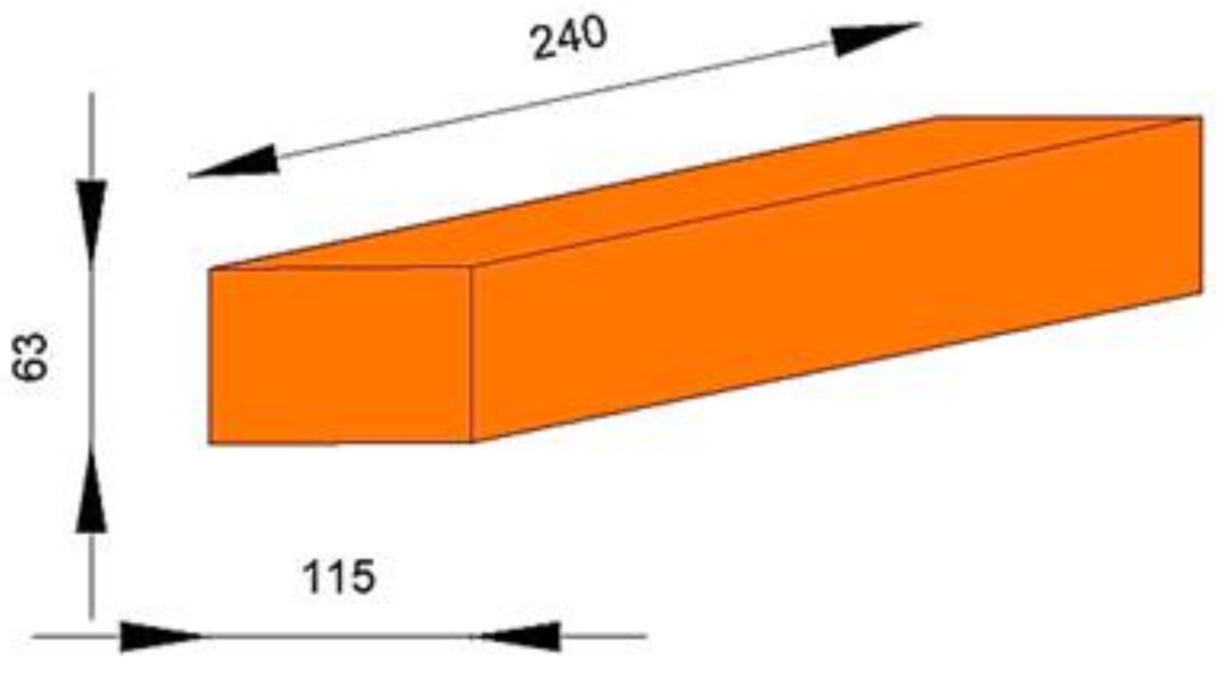
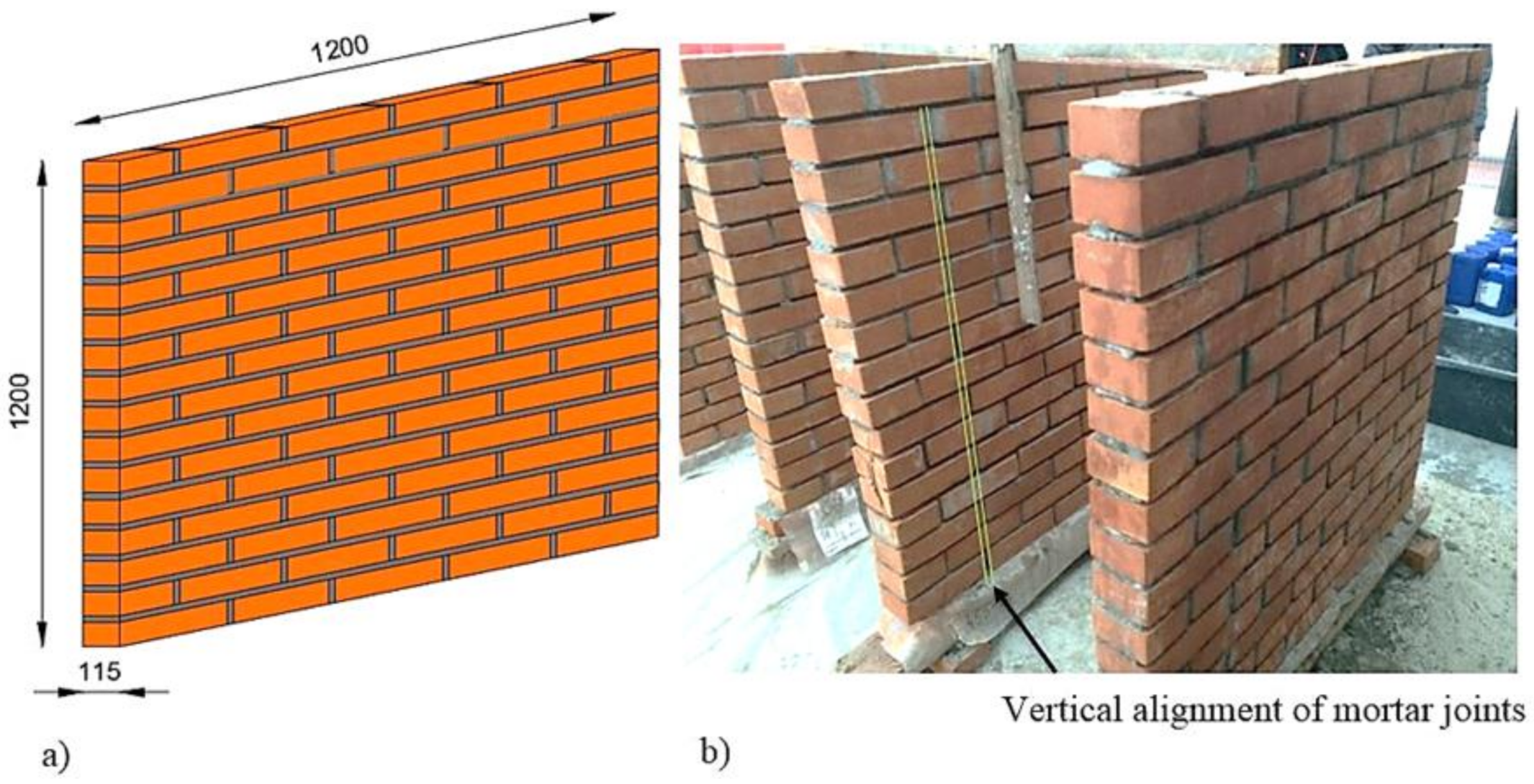


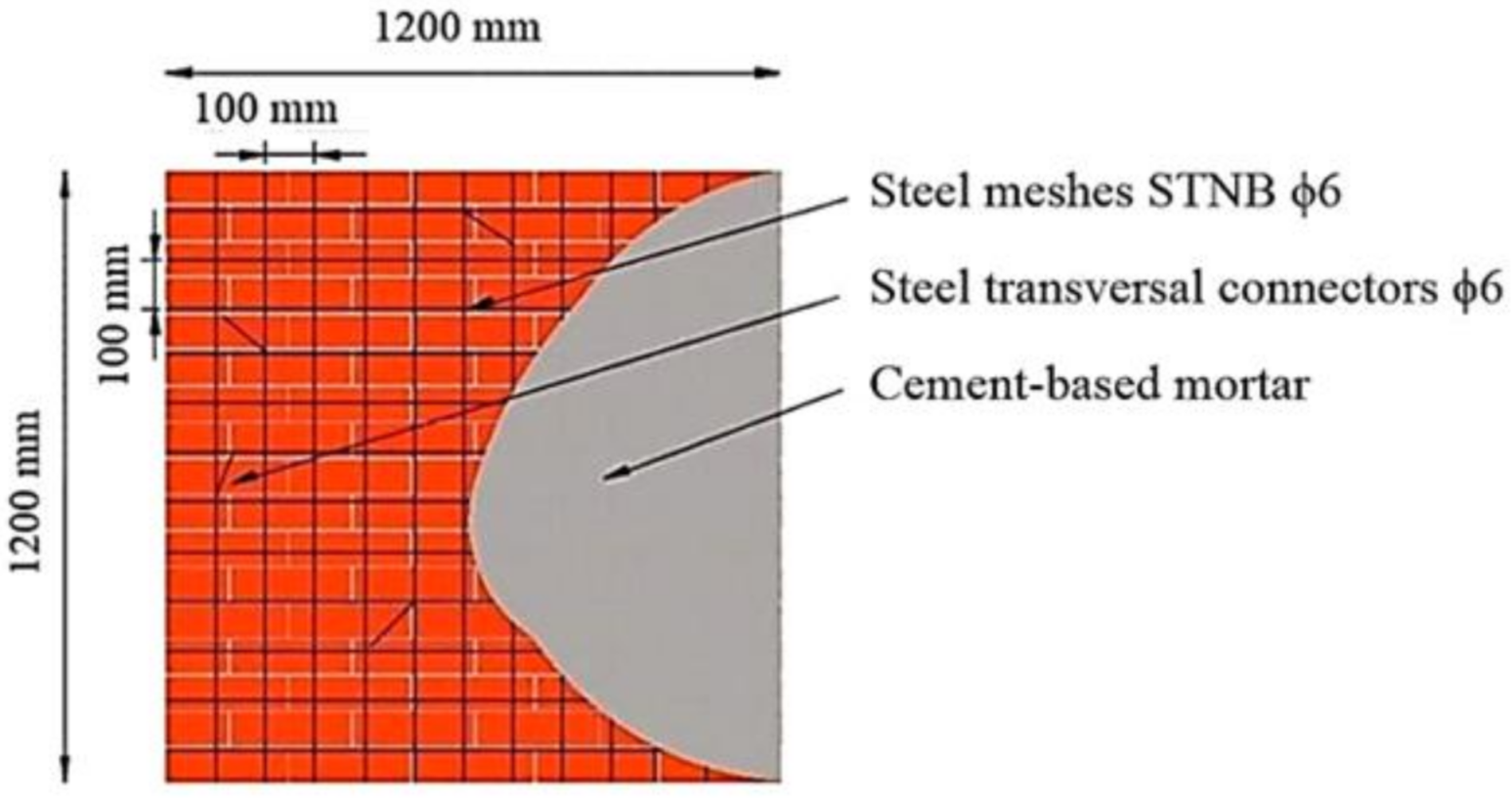
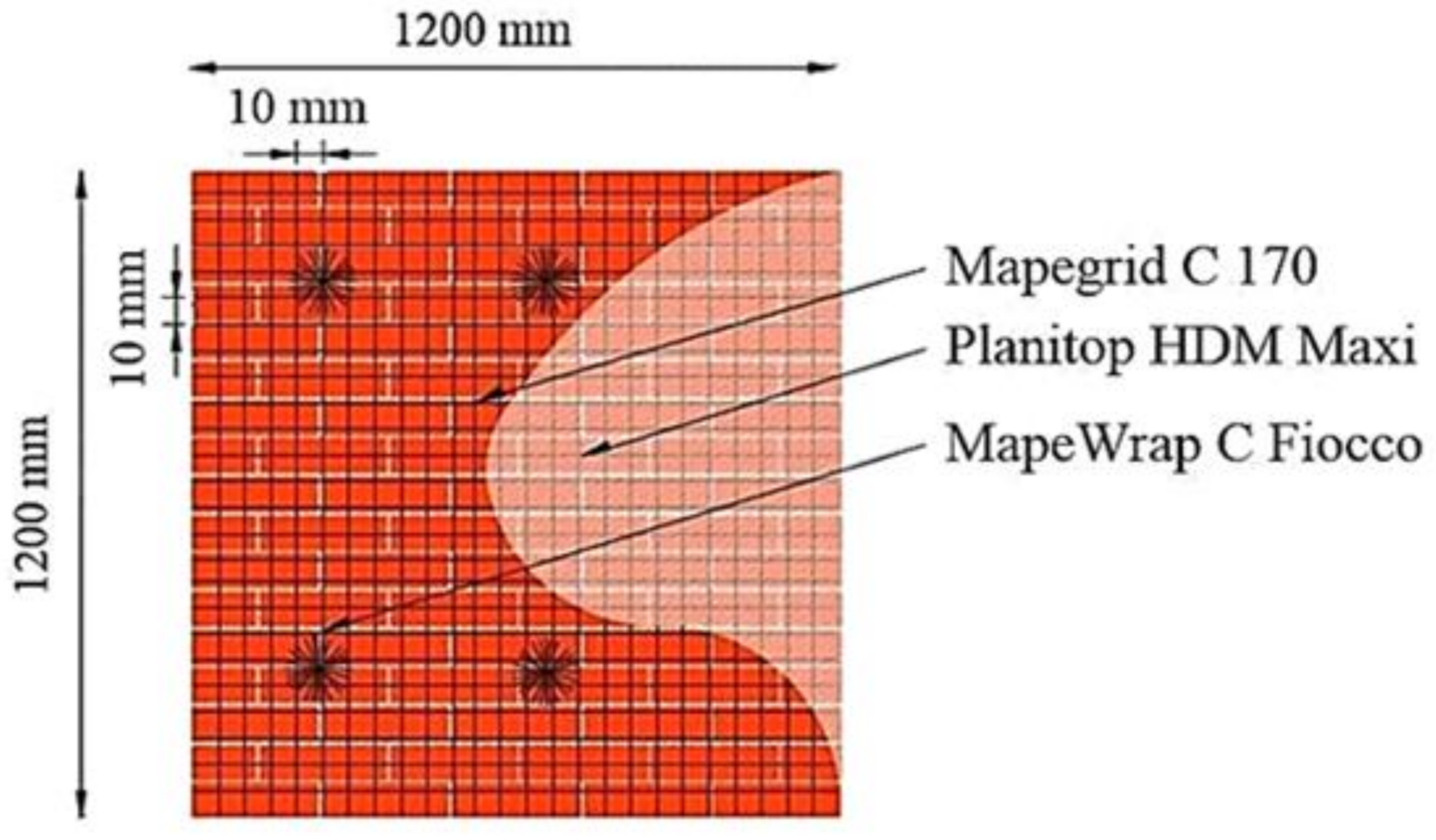


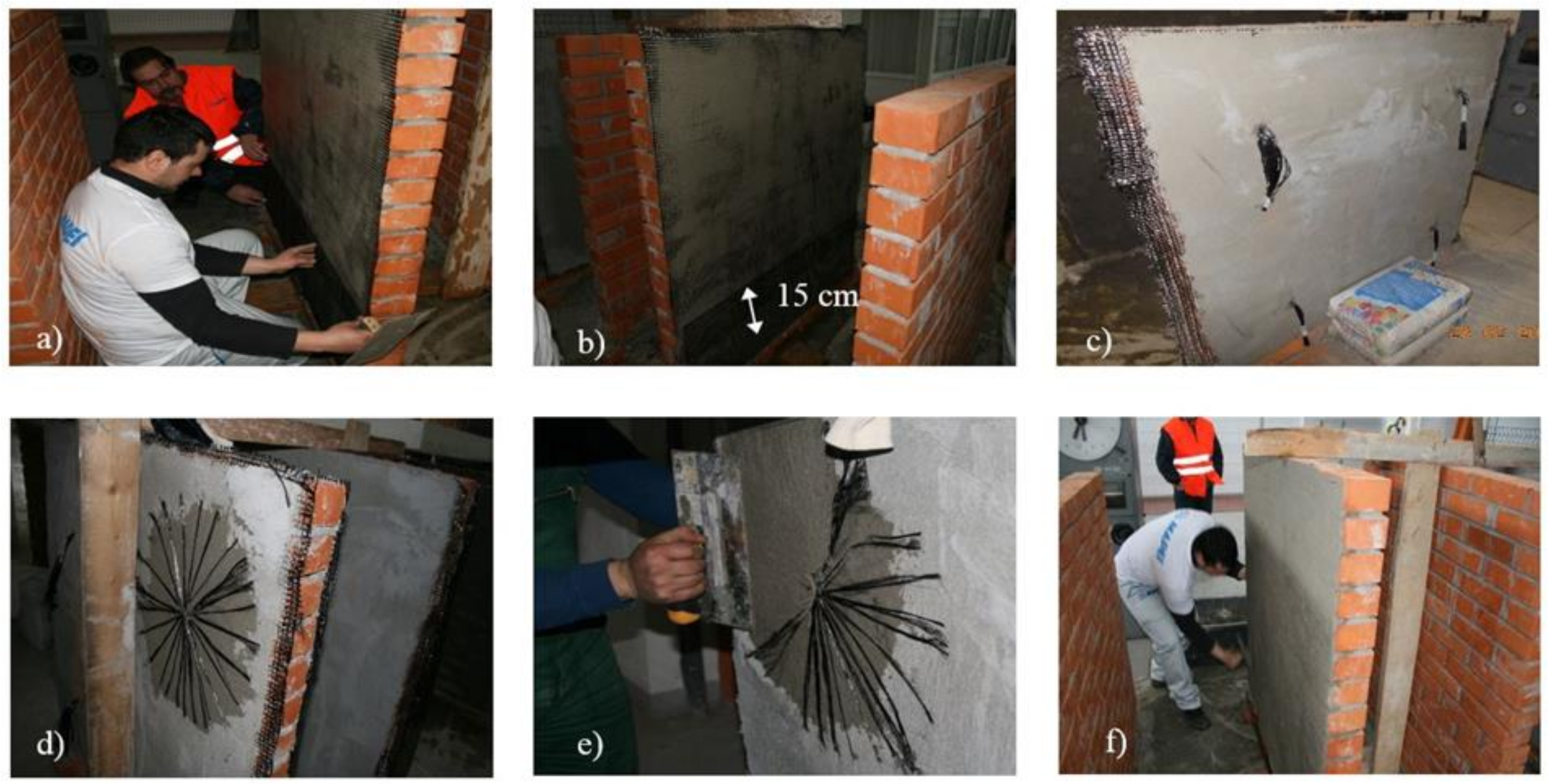
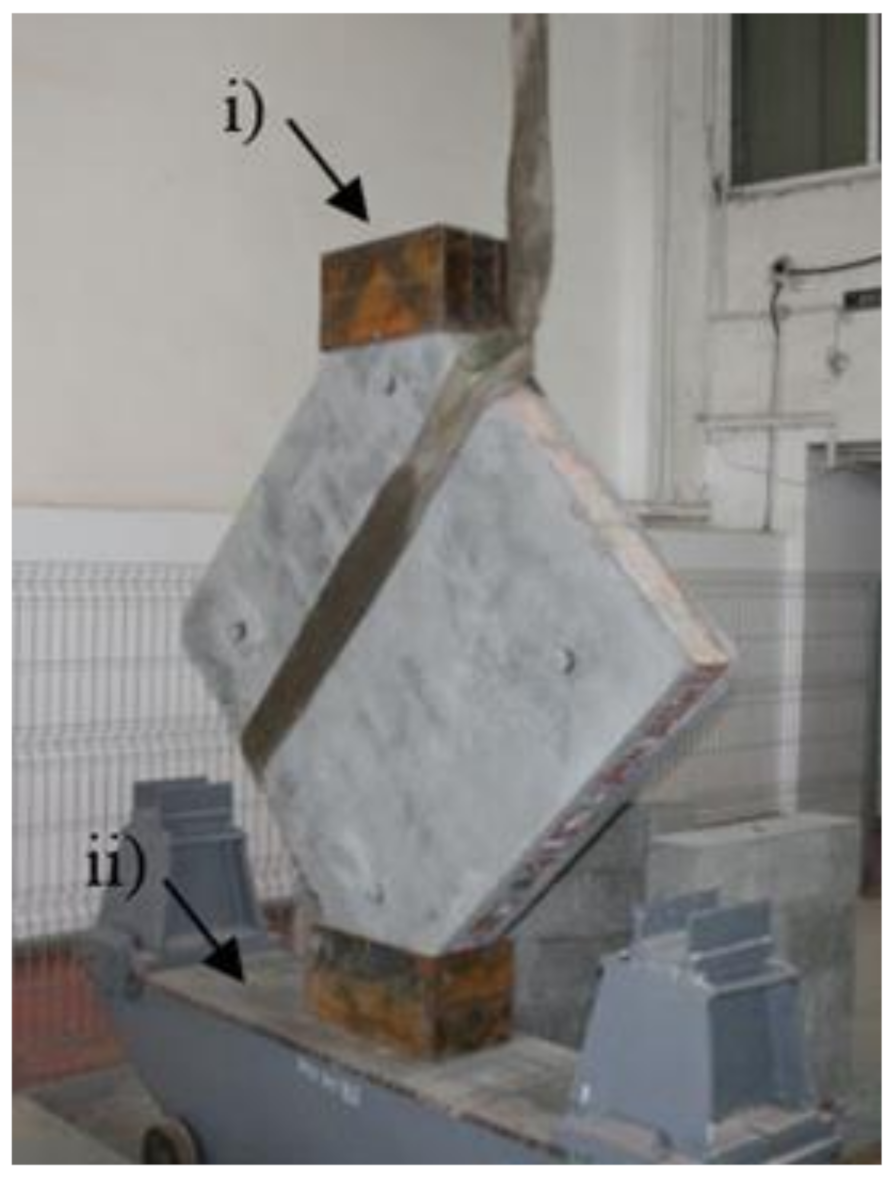
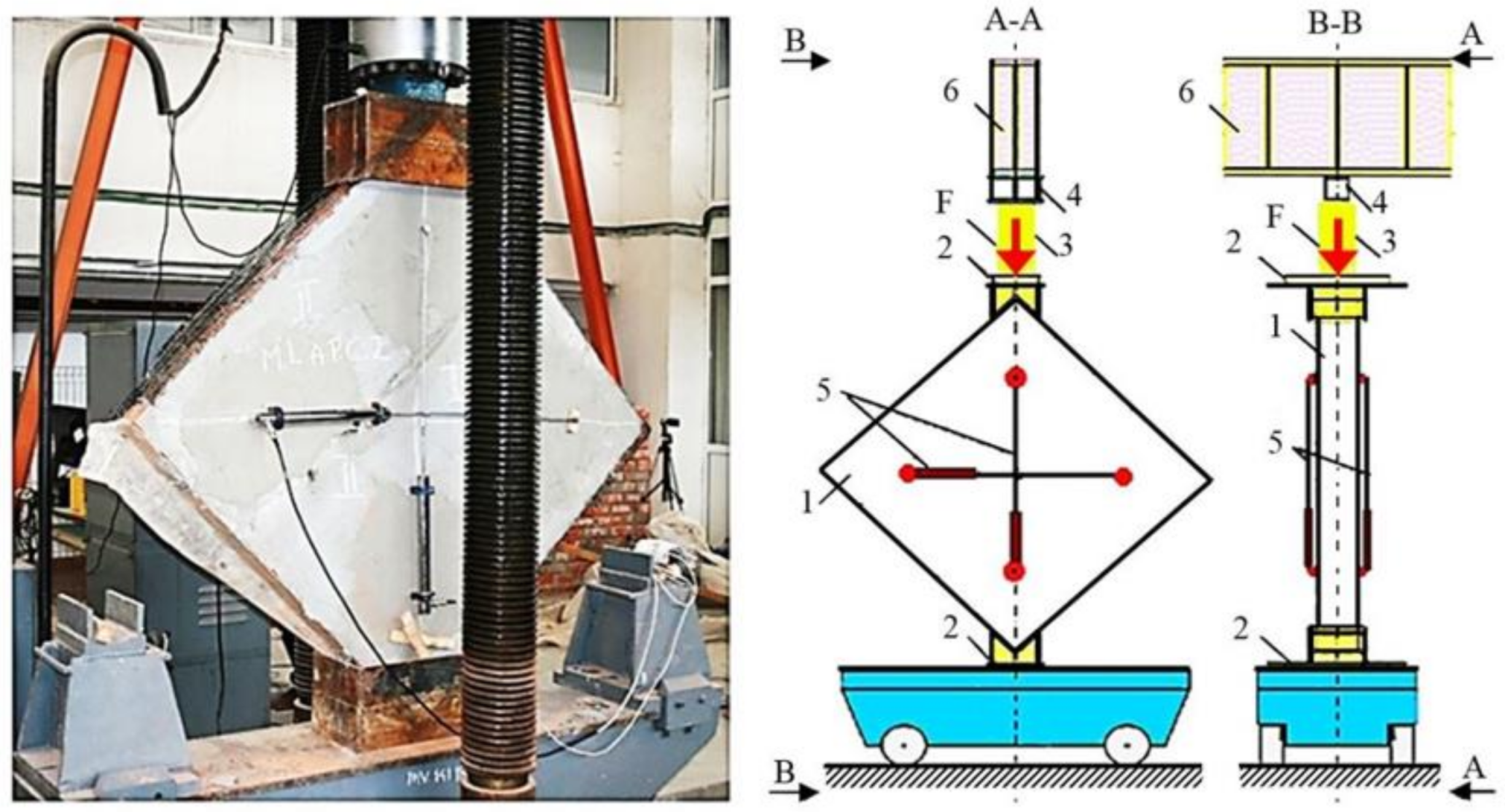


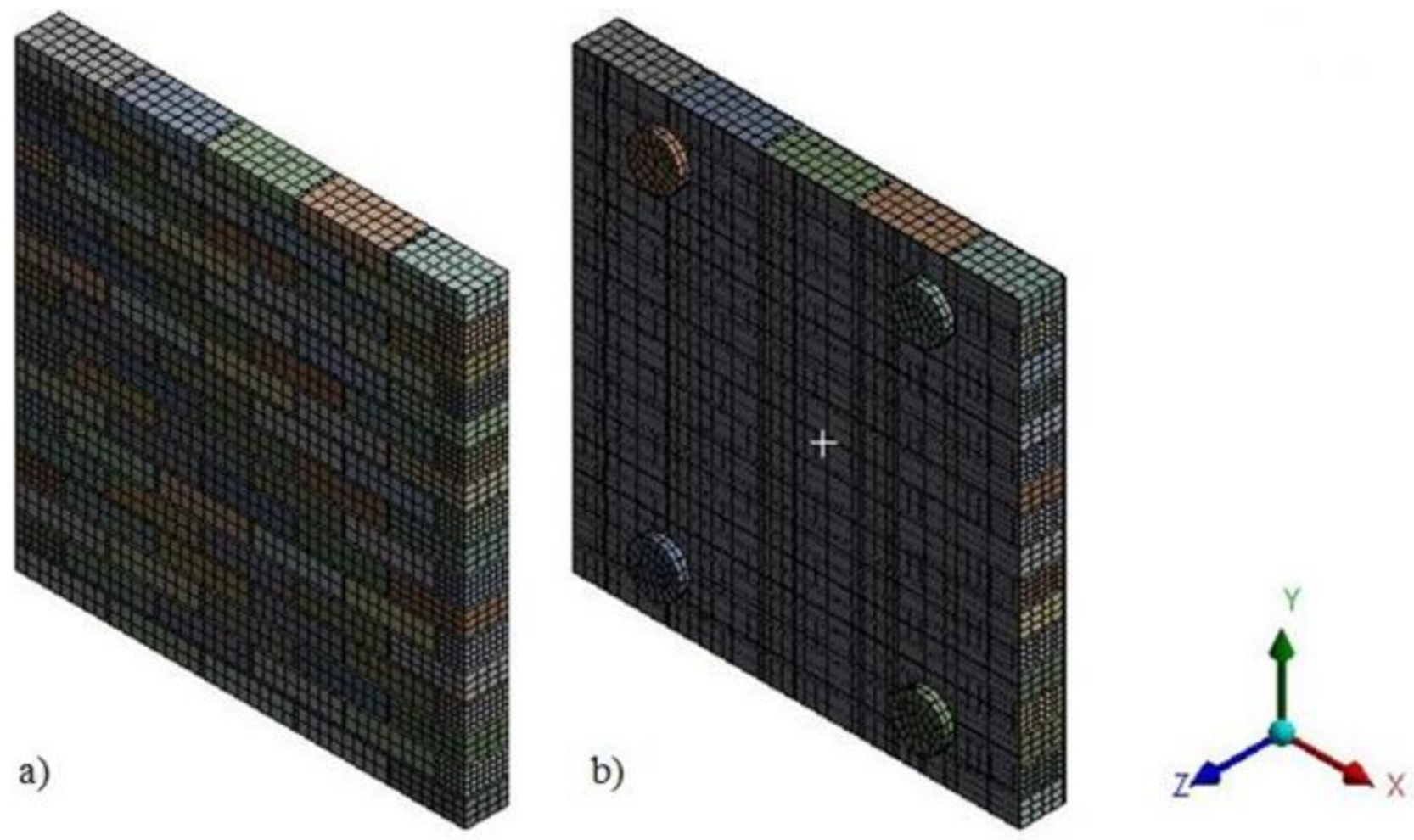
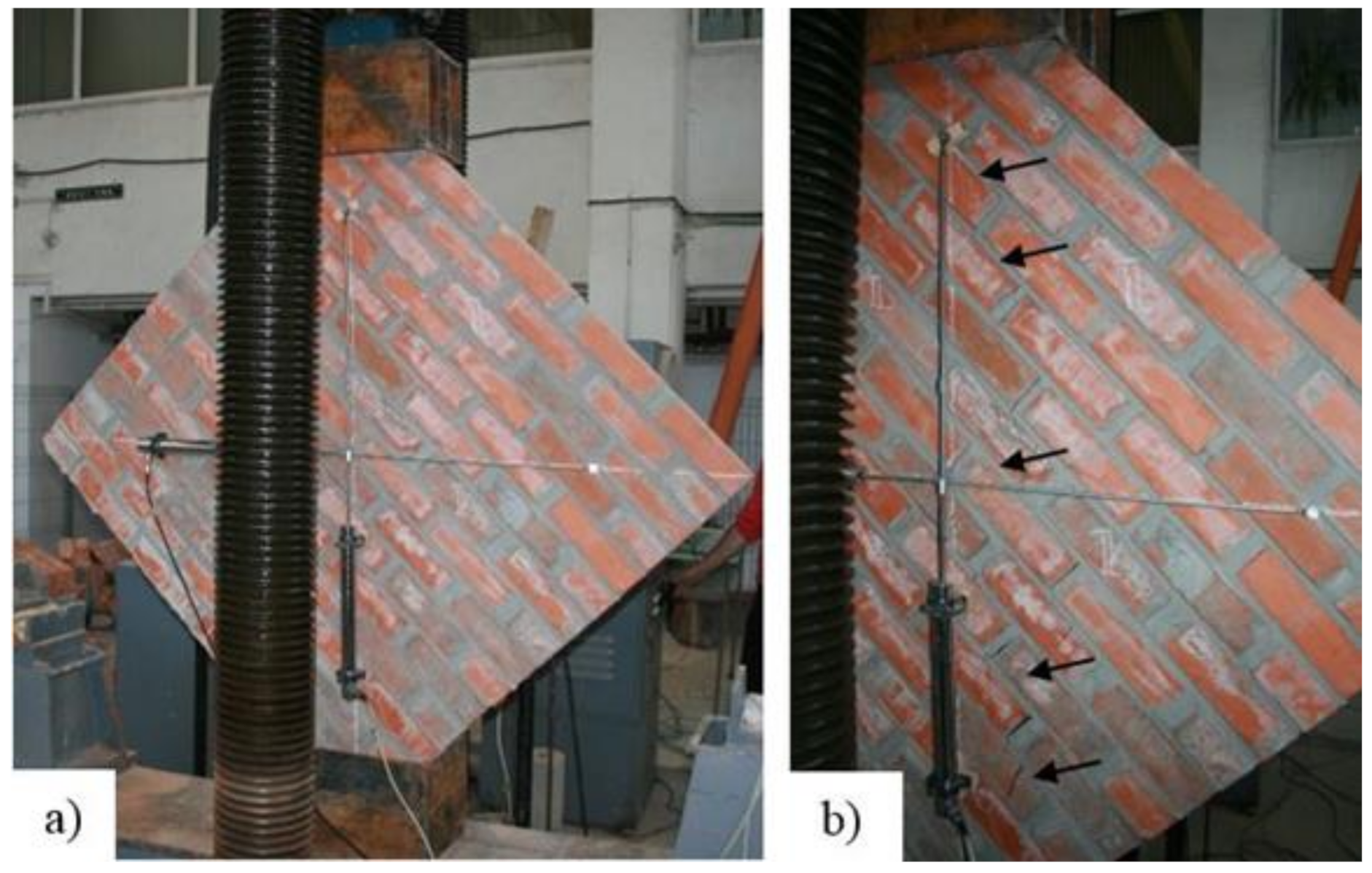
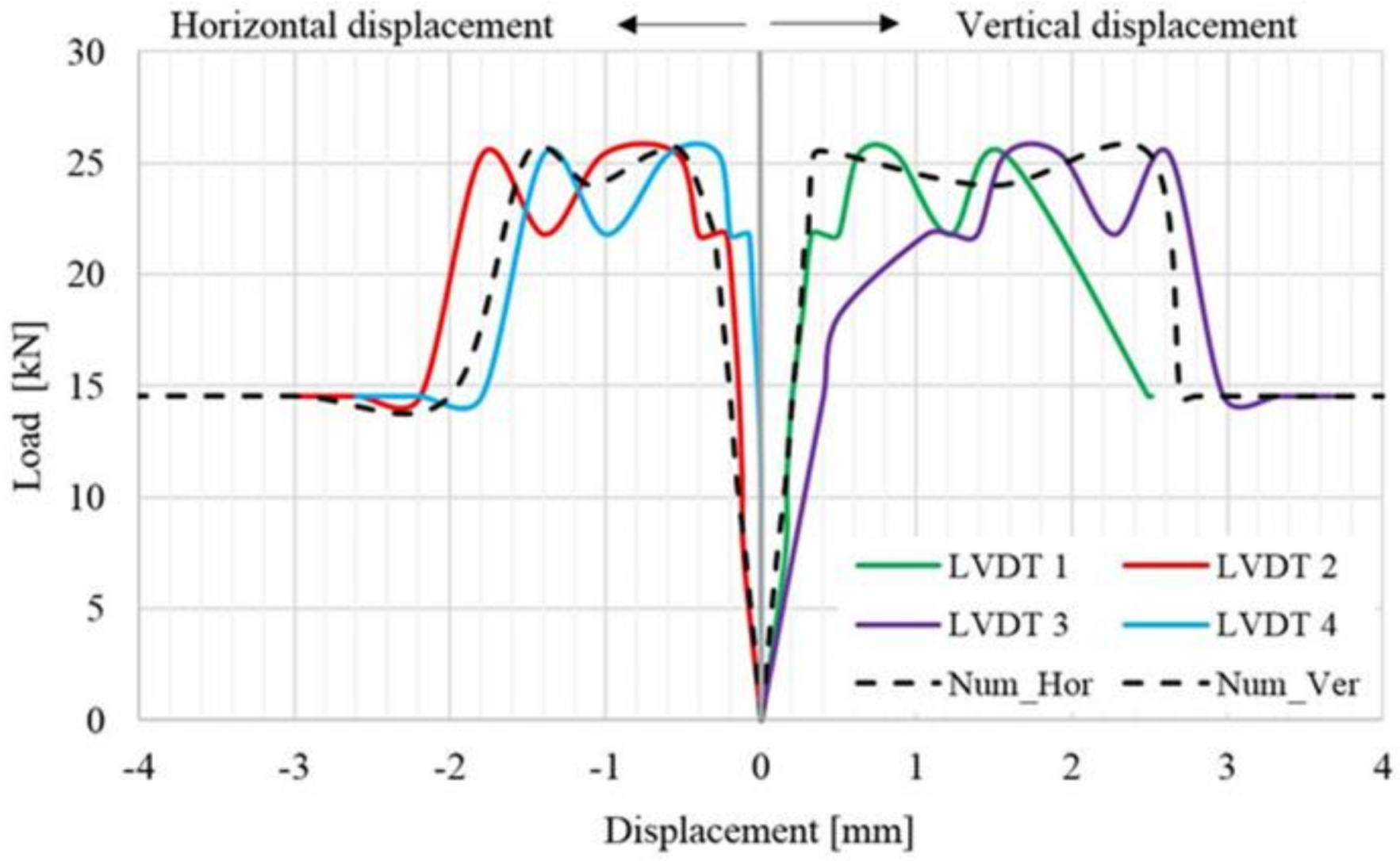
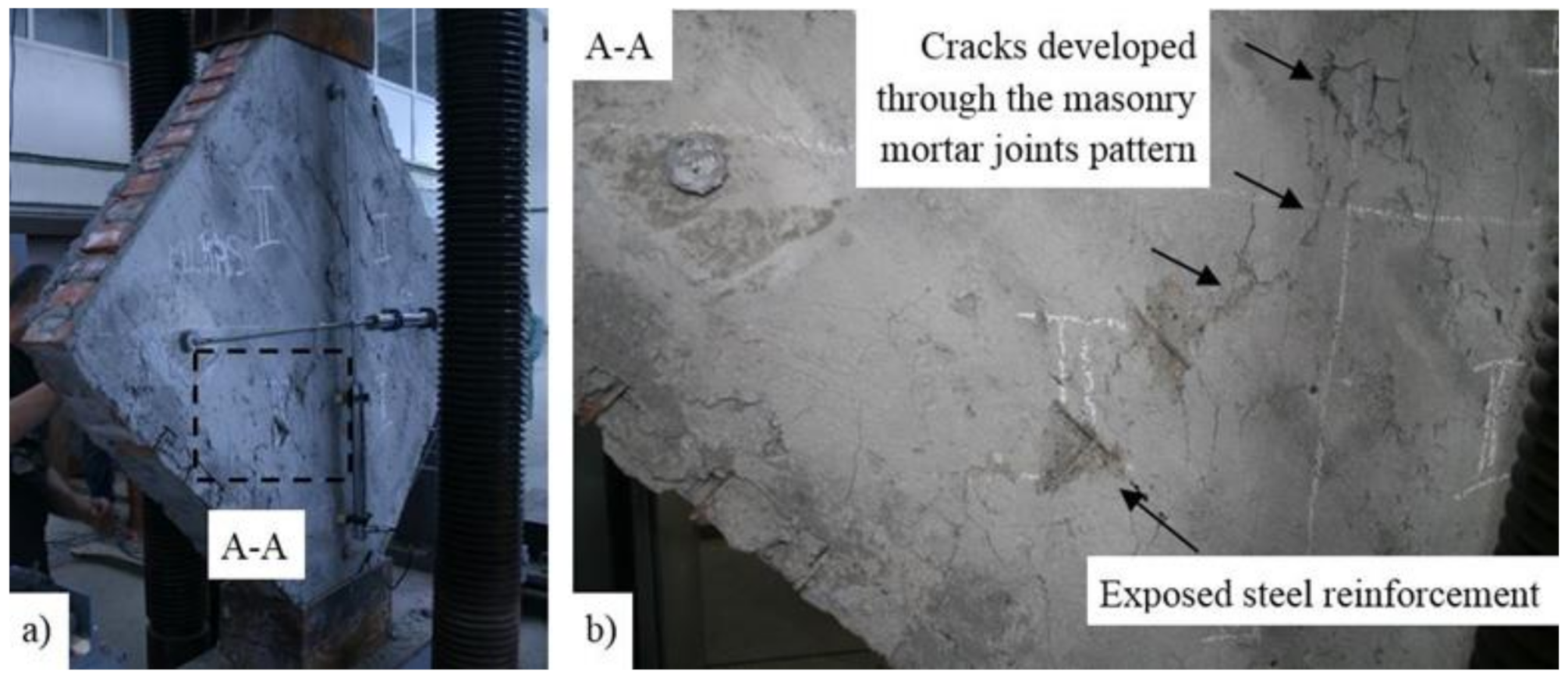

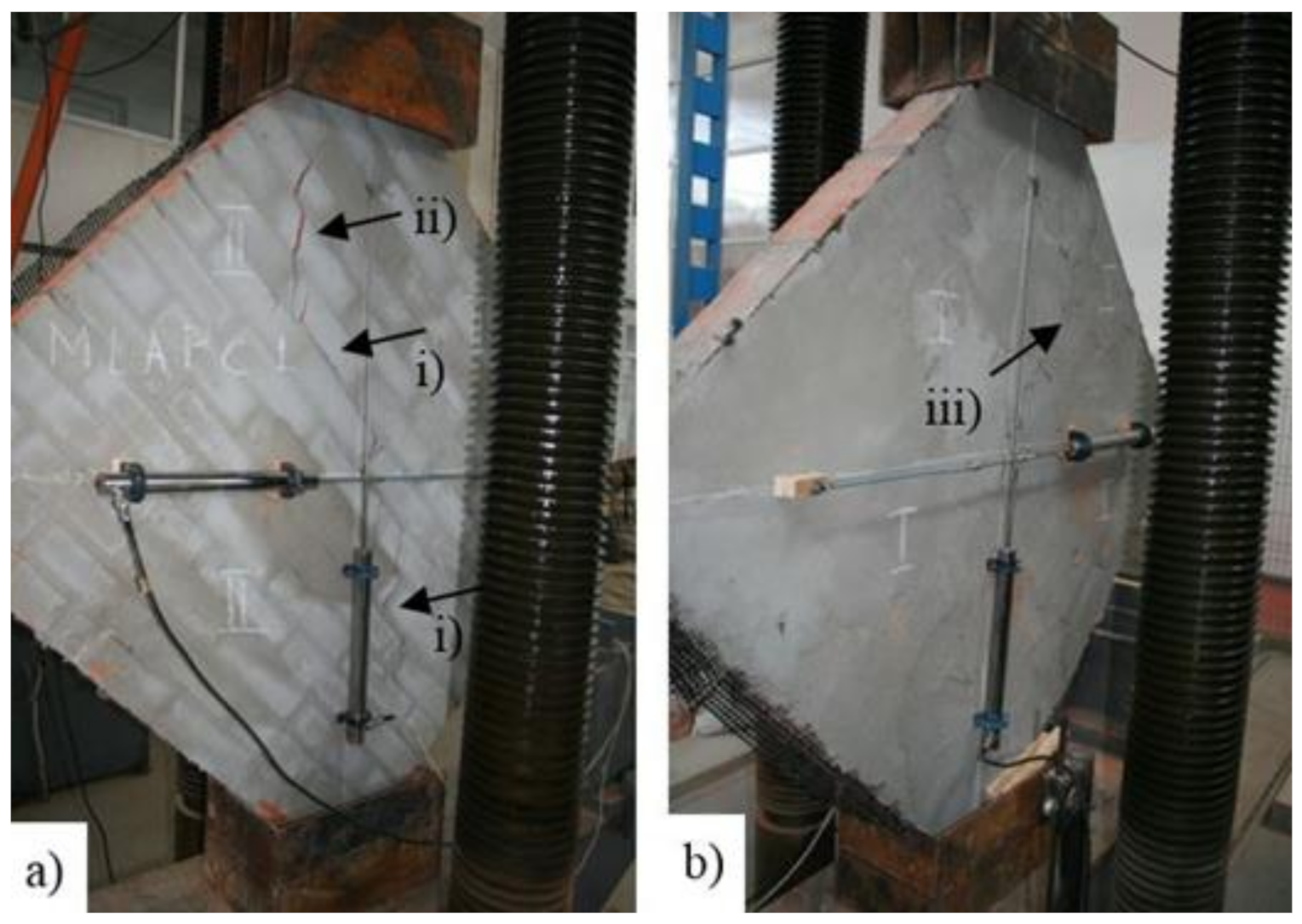
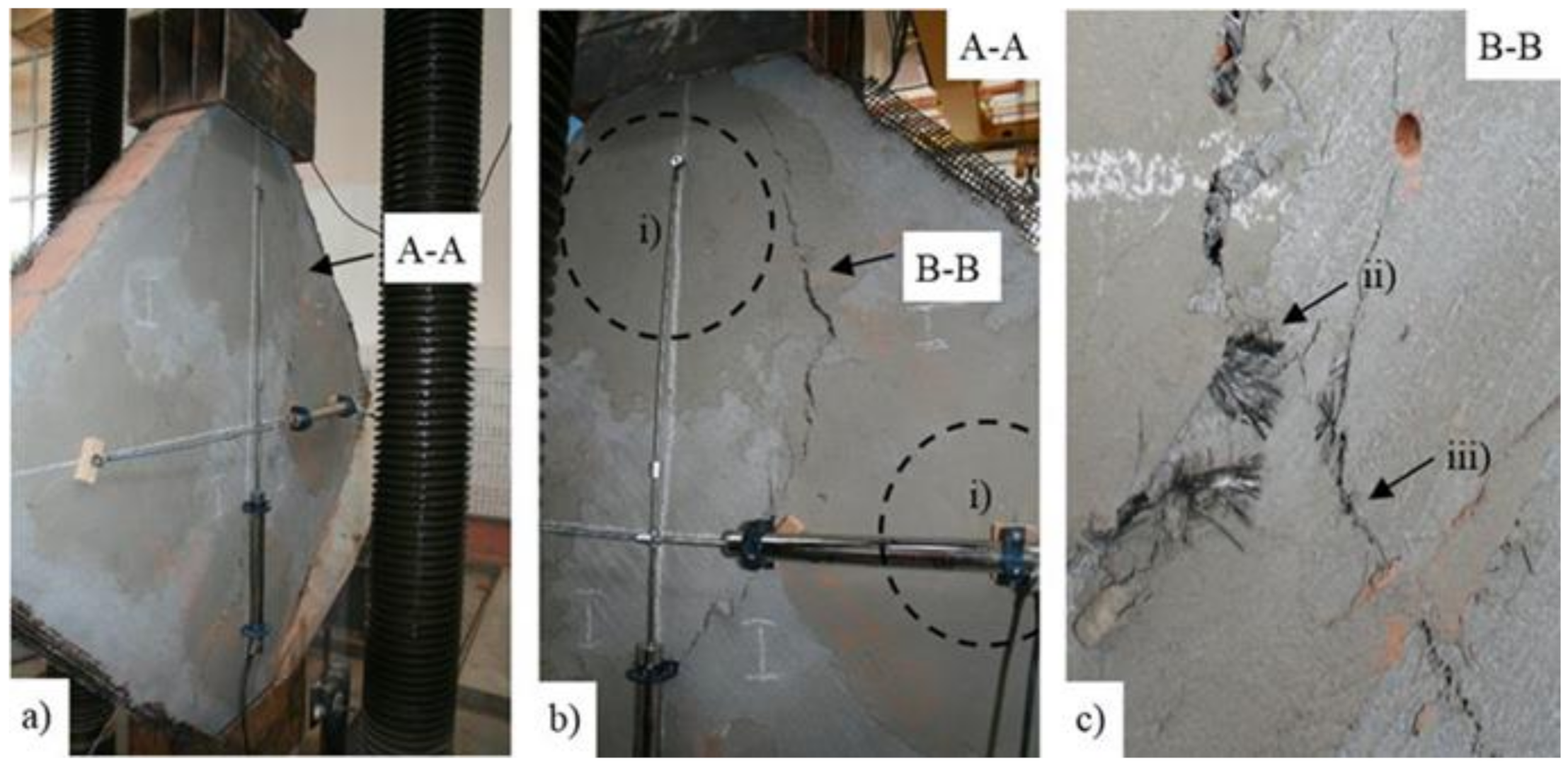
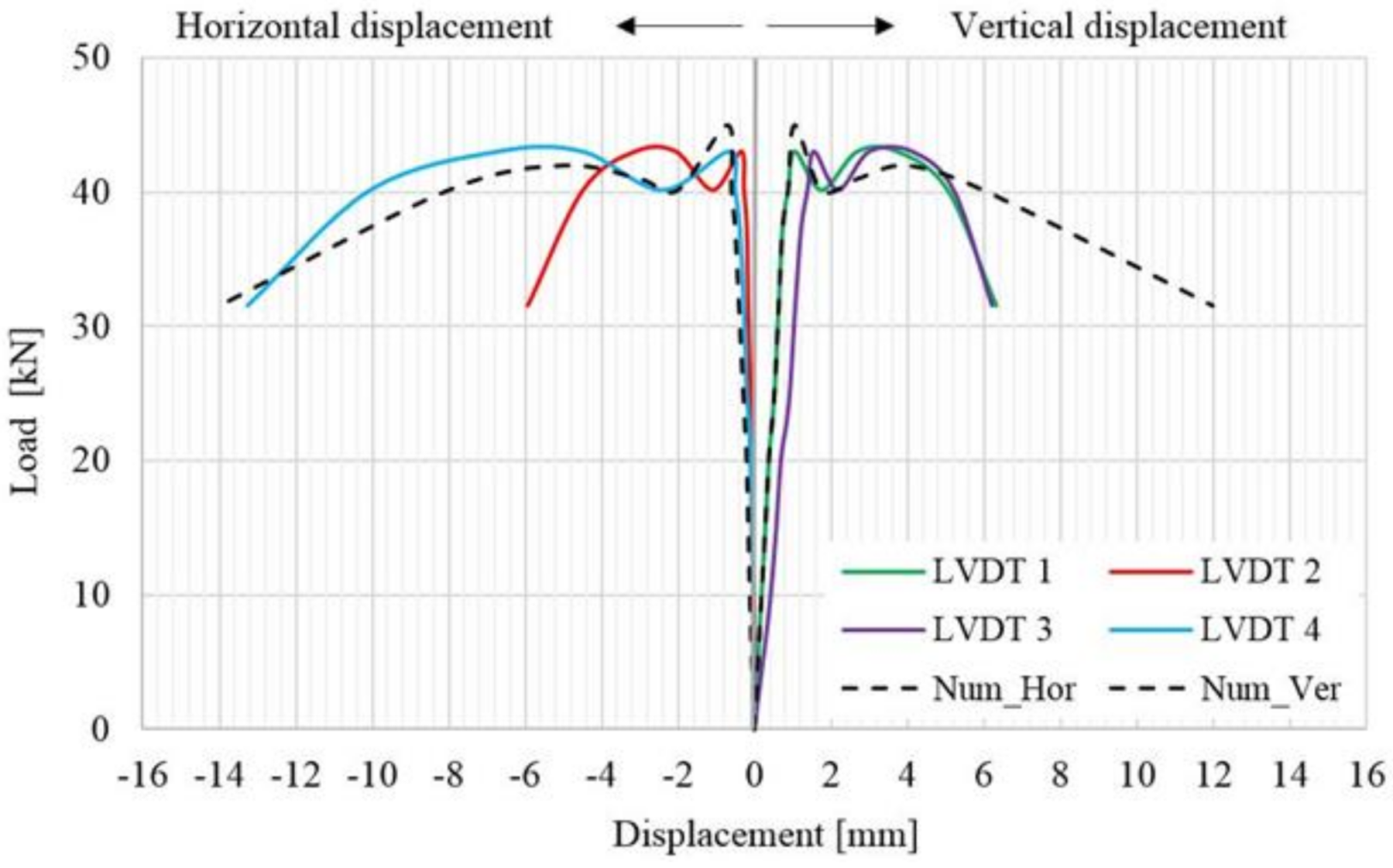
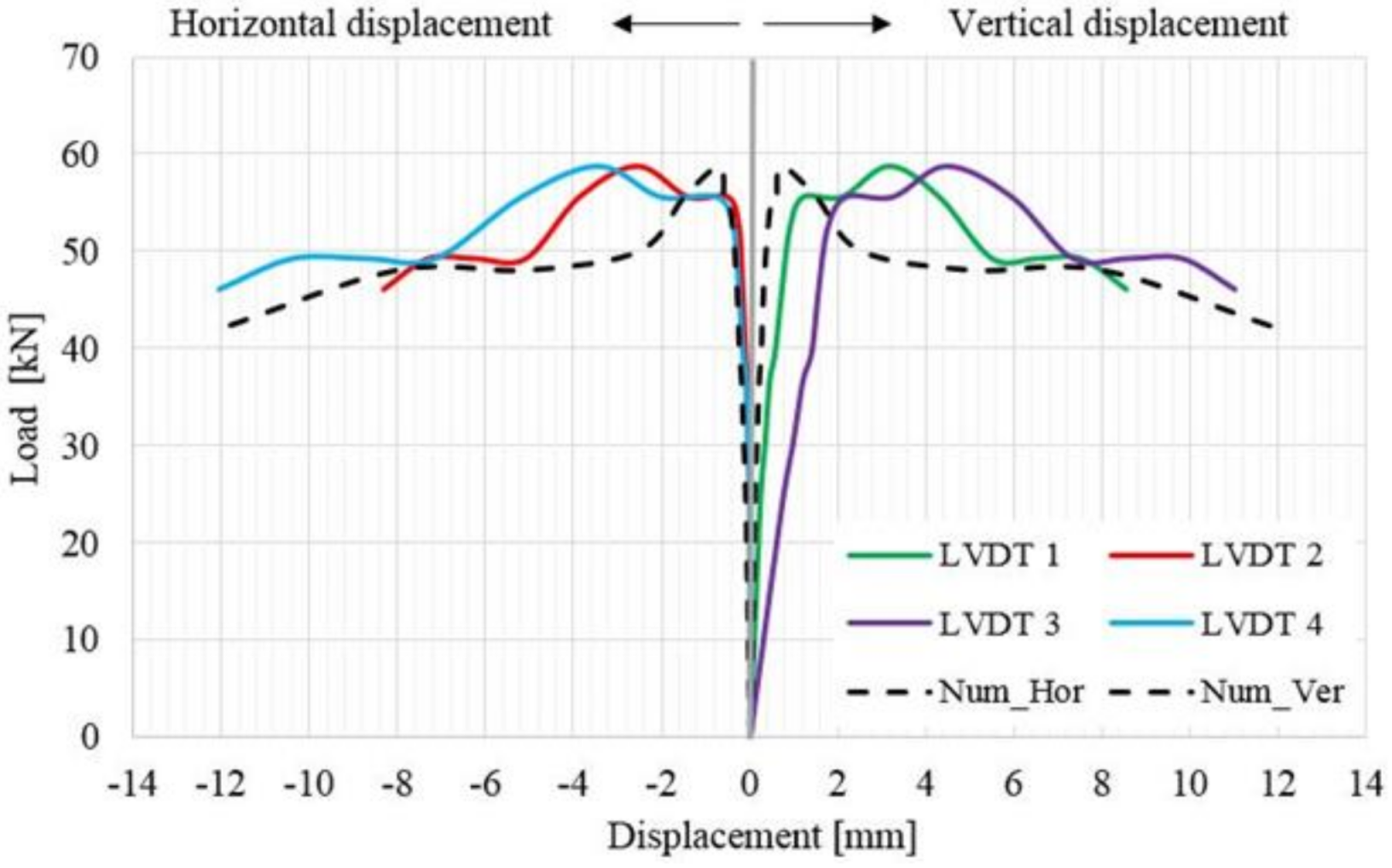
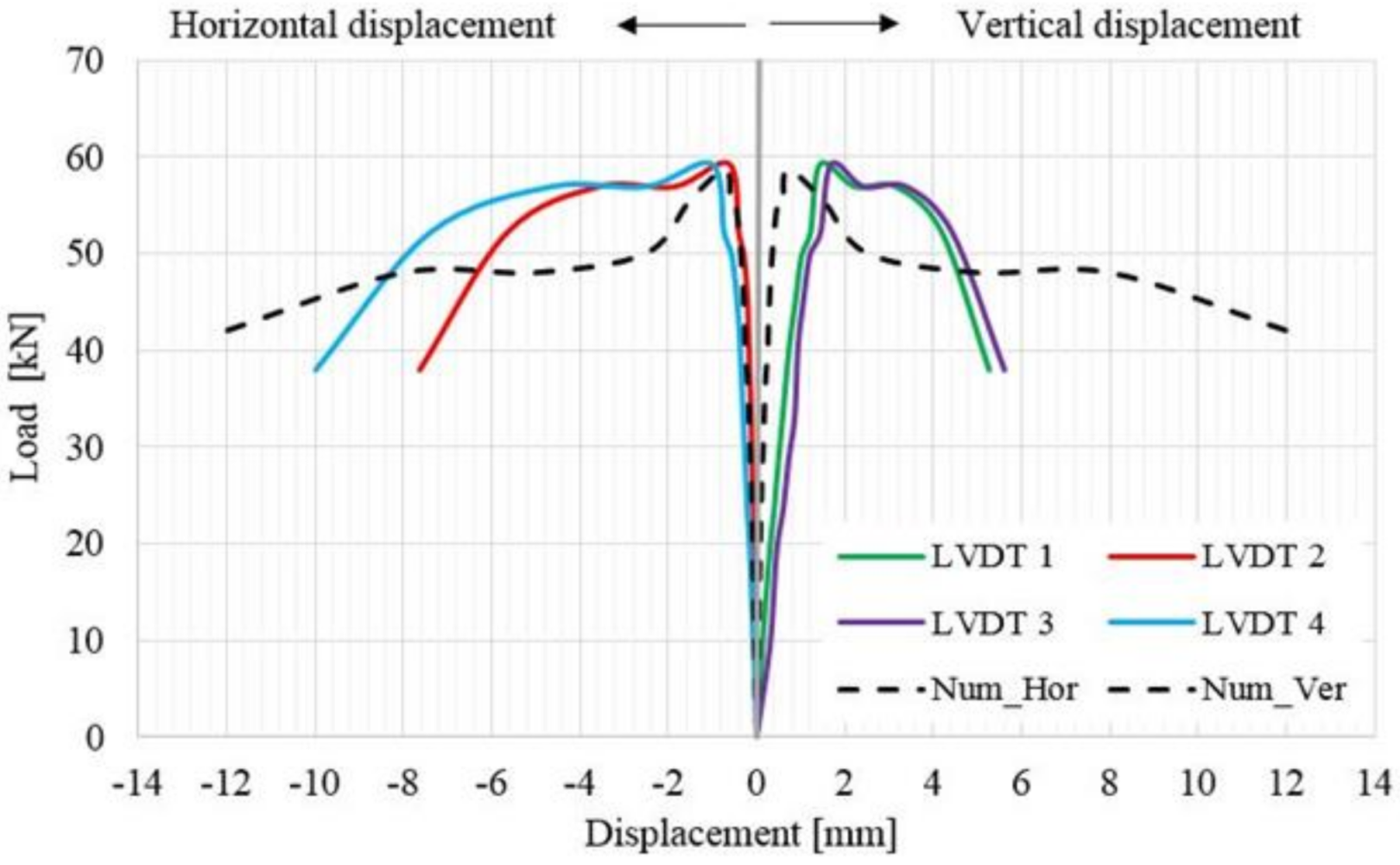
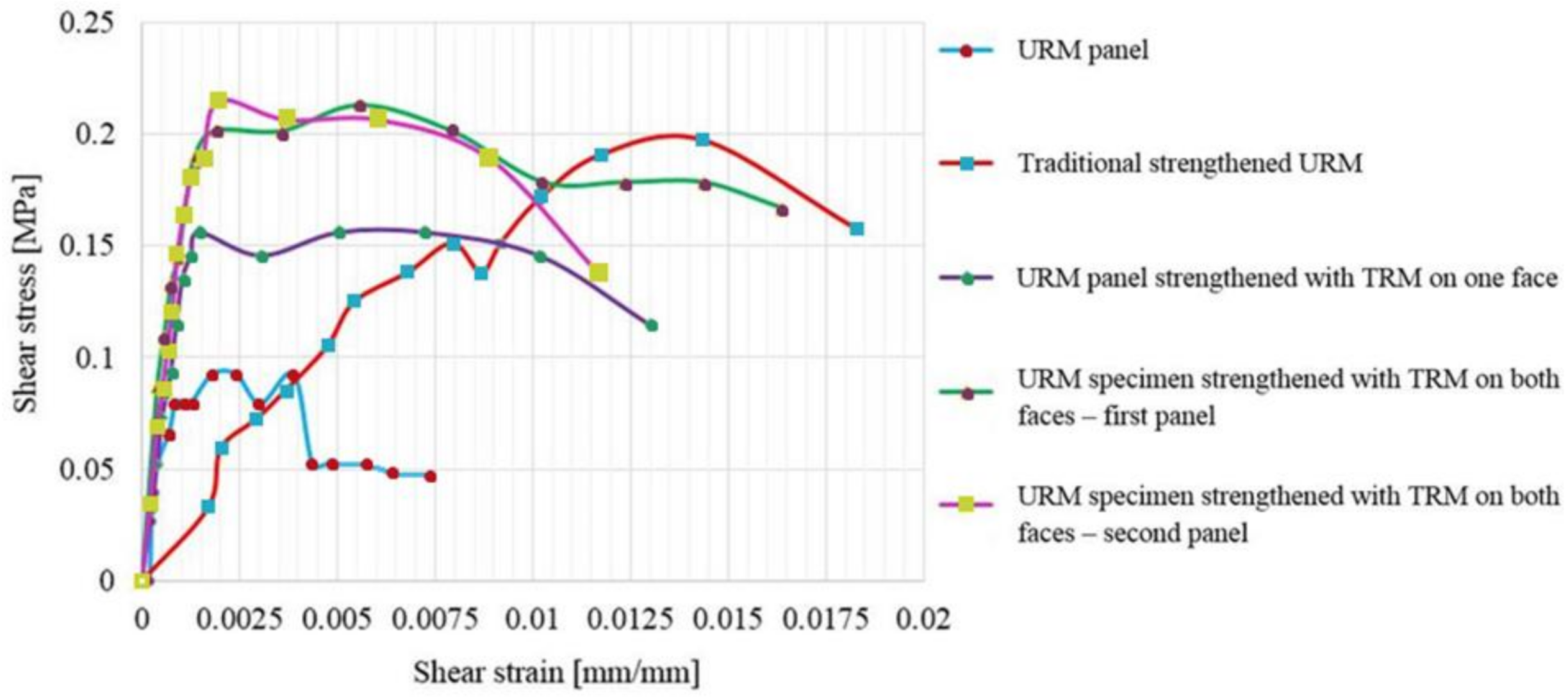
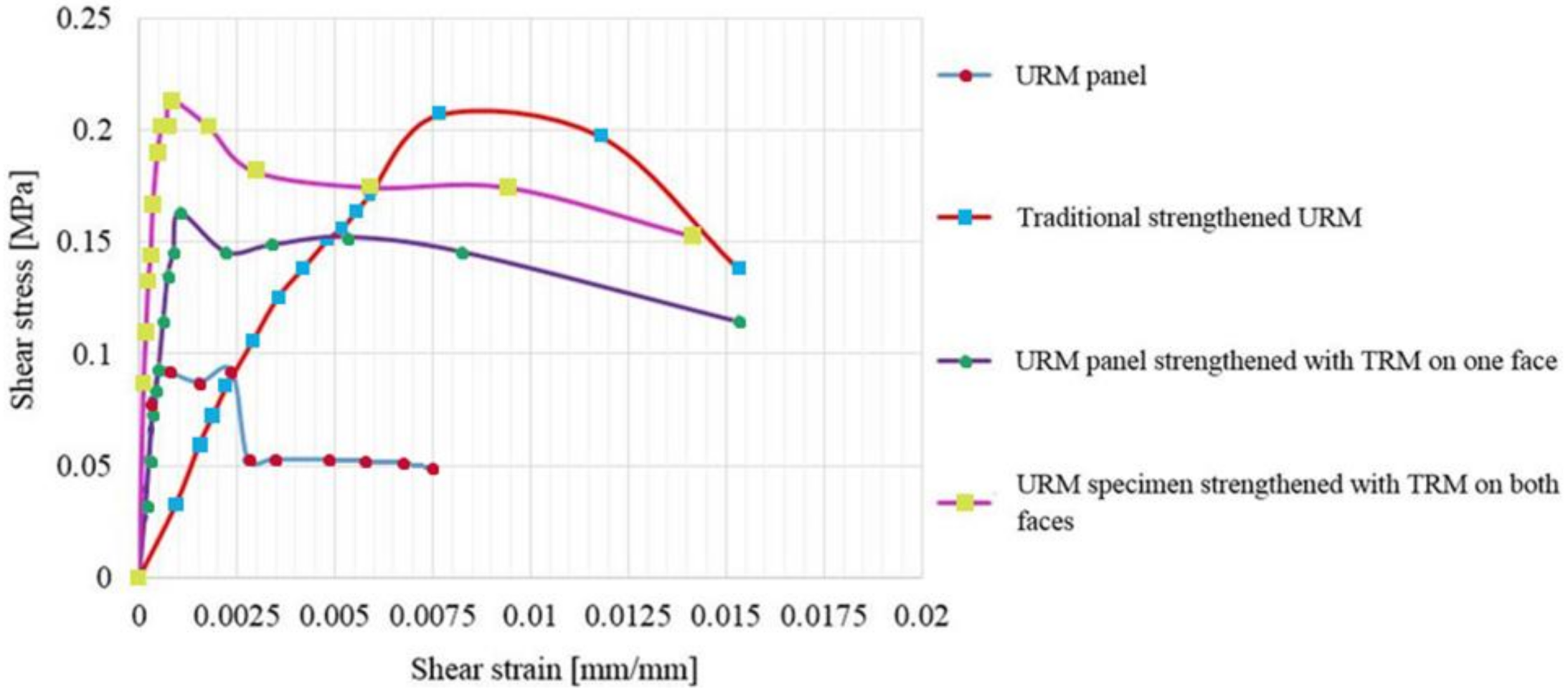
| Authors | Test Type | No. of Panels | Type of Masonry | Type of Reinforcing Meshes | No. of Strengthened Sides | Failure Mechanism | Strength Ratio | Deformation Ratio |
|---|---|---|---|---|---|---|---|---|
| Prota et al., 2006 [33] | DG | 4 | TF | G | 1 | Tensile rupture | 1.7 | 2.4 |
| Prota et al., 2006 [33] | DG | 4 | TF | G | 2 | Crushing | 2.2 | 2.3 |
| Papanicolaou et al., 2007 [37] | SH | 4 | BR | C | 2 | Crushing | 8.2 | 13.5 |
| Crushing | 2.5 | 4.2 | ||||||
| Debonding and crushing | 5.3 | 7.2 | ||||||
| Faella et al., 2010 [38] | DG | 9 | TF | C | 1 | Debonding and crushing | 5.7 | --- |
| Augenti et al., 2011 [39] | CY | 1 | BR | G | 1 | Tensile rupture | 1.03 | 2.8 |
| Parisi et al., 2013 [40] | DG | 6 | TF | G | 1/2 | Tensile rupture | 2.4 | 2.7 |
| Ismail and Ingham, 2016 [29] | CY | 1 | BR | S | 1 | Tensile rupture | 1.2 | 1.2 |
| Marcari et al., 2017 [32] | DG | 3 | TF | B | 1 | Vertical cracks | 1.3 | 2.4 |
| Marcari et al., 2017 [32] | DG | 2 | TF | B | 2 | Vertical cracks | 1.6 | 1.6 |
| Sagar et al., 2017 [31] | DG | 15 | BR | G | 1 | Tensile rupture | 1.03 | 7.2 |
| Longo et al., 2021 [41] | DG | 2 | BR | G | 2 | Vertical cracks | 1.6 | - |
| Longo et al., 2021 [41] | DG | 2 | BR | S | 2 | Tensile rupture | 1.7 | - |
| Donnini et al., 2021 [42] | DG | 3 | TF | G | 2 | Vertical cracks | 2.7 | 4.0 |
| Donnini et al., 2021 [42] | DG | 3 | BR | G | 2 | Vertical cracks | 1.3 | 1 |
| Consistency of mix | Plastic–thixotropic |
| Density of wet mix (kg/m3) | 1850 |
| Coating | Epoxy–Silicone–PFT–Titanium |
| Workability (h) | 1 |
| Water absorption (kg/(m2·min0.5) | ≤0.1 |
| Thermal conductivity (W/m·K) | 0.73 |
| Compressive strength (MPa) | 25 (after 28 days) |
| Flexural strength (MPa) | 8 (after 28 days) |
| Compressive modulus of elasticity (MPa) | 10,000 (after 28 days) |
| Initial shear strength (MPa) | 0.15 |
| Type of Fiber | High-Strength Carbon Fiber |
|---|---|
| Weight (g/m2) | 170 |
| Mesh size (mm) | 10 × 10 |
| Density (kg/m3) | 1830 |
| Tensile strength (MPa) | 4800 |
| Modulus of elasticity (MPa) | 230,000 |
| Load-resistant area per unit of width (mm2/m) | 48 |
| Equivalent thickness of dry fabric (mm) | 0.048 |
| Elongation at failure (%) | 2 |
| Type of Fiber | High-Strength Carbon Fiber |
|---|---|
| Appearance | cord |
| Density (kg/m3) | 1800 |
| Equivalent surface area of dry fabric (mm2) | 21.24 |
| Modulus of elasticity (MPa) | 230,000 |
| Tensile strength (MPa) | 4830 |
| Elongation at failure (%) | 2 |
| Appearance | Thixotropic Paste |
|---|---|
| Density (kg/m3) | 1690 |
| Compressive strength (MPa) | 68 |
| Flexural strength (MPa) | 30 |
| Flexural dynamic modulus of elasticity (MPa) | 4025 |
| Compressive modulus of elasticity (MPa) | 6105 |
| Characteristics | URM | TSM | TRM1 | TRM2 | TRM3 |
|---|---|---|---|---|---|
| Pult_exp (kN) | 25.432 | 54.378 | 43.024 | 58.695 | 59.364 |
| Pult_num (kN) | 24.900 | 57.210 | 45.155 | 58.345 | 58.345 |
| Ss_exp (MPa) | 0.043 | 0.157 | 0.114 | 0.167 | 0.137 |
| Ss_num (MPa) | 0.042 | 0.138 | 0.114 | 0.152 | 0.152 |
| Ɣexp (mm/mm) | 0.007 | 0.017 | 0.012 | 0.015 | 0.012 |
| Ɣnum (mm/mm) | 0.008 | 0.015 | 0.015 | 0.014 | 0.014 |
| Gexp (MPa) | 6.142 | 9.235 | 9.500 | 11.133 | 11.417 |
| Gnum (MPa) | 5.250 | 9.200 | 7.600 | 10.857 | 10.857 |
| Eexp (MPa) | 15.355 | 23.088 | 23,750 | 27.833 | 28.542 |
| Enum (MPa) | 13.125 | 23.000 | 19.000 | 27.143 | 28.843 |
| δu_exp (%) | 0.220 | 0.609 | 0.473 | 0.650 | 0.331 |
| δu_num (%) | 0.236 | 0.884 | 0.707 | 0.707 | 0.707 |
Publisher’s Note: MDPI stays neutral with regard to jurisdictional claims in published maps and institutional affiliations. |
© 2021 by the authors. Licensee MDPI, Basel, Switzerland. This article is an open access article distributed under the terms and conditions of the Creative Commons Attribution (CC BY) license (https://creativecommons.org/licenses/by/4.0/).
Share and Cite
Ungureanu, D.; Țăranu, N.; Ghiga, D.A.; Isopescu, D.N.; Mihai, P.; Cozmanciuc, R. Diagonal Tensile Test on Masonry Panels Strengthened with Textile-Reinforced Mortar. Materials 2021, 14, 7021. https://doi.org/10.3390/ma14227021
Ungureanu D, Țăranu N, Ghiga DA, Isopescu DN, Mihai P, Cozmanciuc R. Diagonal Tensile Test on Masonry Panels Strengthened with Textile-Reinforced Mortar. Materials. 2021; 14(22):7021. https://doi.org/10.3390/ma14227021
Chicago/Turabian StyleUngureanu, Dragoș, Nicolae Țăranu, Dan Alexandru Ghiga, Dorina Nicolina Isopescu, Petru Mihai, and Ruxandra Cozmanciuc. 2021. "Diagonal Tensile Test on Masonry Panels Strengthened with Textile-Reinforced Mortar" Materials 14, no. 22: 7021. https://doi.org/10.3390/ma14227021
APA StyleUngureanu, D., Țăranu, N., Ghiga, D. A., Isopescu, D. N., Mihai, P., & Cozmanciuc, R. (2021). Diagonal Tensile Test on Masonry Panels Strengthened with Textile-Reinforced Mortar. Materials, 14(22), 7021. https://doi.org/10.3390/ma14227021








